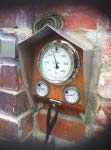Concrete Calculator - volume vs. weight
Calculator for weight of concrete amounts, between weight and volume equivalent measurements from lb^3, yd^3, cubic meter of concrete into mass measures in pounds, kilograms, tons.
Enter Concrete Amount:
Precision:
Choose a concrete From unit:
Choose a concrete To unit:
The concrete calculator is calibrated to exactly 23.60 kN/m3 unit weight per concrete volume. Which is, as Internationally defined, how heavy is normal reinforced concrete. In USCS units (United States Customary System units), its weight comes to ~150lb/ft3 and ~2,400 kg/m3 if measured in Metric SI system. The concrete converter can be applied in construction and structural engineering for exchange from volumes of concrete quantities into their equivalents in mass. Extensive list of concrete measuring units.
You may enter whole numbers, decimals or fractions ie: 5, 75.33, 45 1/4
The maths for mass density to volume units calculation for concrete weight is as follows:
23,600 m^-2 kg s^-2
or in a different maths form
23600(m^(-2)) (kg (s^(-2)))
23.60 kN/m3 multiply by
1000 N/1 kN multiply by
1 lb/4.45 N multiply by
1 m3/3.281 cu ft
Where:
kN = kilo Newton (gravity force on concrete on the Earth)
cu mtr = m^3 = m3 = cubic meter
cu ft = ft^3 = ft3 = cubic foot/feet
1000 N = 1 kN
4.45 N = 1 lb (0.454 kg × 9.81 ... to get 4.45 Newtons)
1 meter = 3.281 feet
Dense normal concrete weight
What is the weight of a concrete volume in lb/cu-ft and kg/m3
| concrete volume weight chart: | ||
| Unit | Kilogram | Pound |
| cubic meter of concrete | 2,406.53 kg/m^3 | 5,305.49 lb/m^3 |
| cubic yard of concrete | 1,839.92 kg/yd^3 | 4,056.34 lb/cu yd |
| cubic foot of concrete | 68.15 kg/ft^3 | 150.23 lb/cu ft |
| cubic inch of concrete | 0.039 kg/in^3 | 0.087 lb/cu in |
| cubic centimeter of concrete | 0.002 kg/cm^3 | 0.005 lb/cu cm |
| Japanese cubic shaku of concrete | 66.97 kg/尺^3 | 147.63 lb/cu 尺 |
| Chinese lìfāng mǐ of concrete (equals 1 m3) | 2,406.53 kg/立方米 | 5,305.49 lb/立方米 |
What is the nominal weight of standard concrete?
How heavy is concrete?
The weight of concrete can vary slightly depending on the mix type. The most typical value widely used is 150 lb/ft^3 for the most common/ordinary concrete strength at ~ 4,000 psi = 4000 lbf / (sq in). The aggregate used, strength of concrete and how thin or semi dry the concrete is prepared are the aspects for concrete weight. Even though the aggregate is denser and heavier than water (4 parts of the aggregate is contained within the concrete - add 1 part dry cement + water, 4:1 always in volume sense is the usual standard concrete mixing ratio), wet fresh concrete before it sets will not be much heavier nor lighter per volume unit because the water presence is adding to its total weight. Though, to be exact, there is the marginal drying shrinkage caused by the water evaporation from the fresh concrete which causes a slight weight difference between the soft and set concrete state ... read further down.
Help information for concrete mixing 1 with lime 4:1:1 and concrete mixing 2 refractory and concrete mixing 3 light weight with vermiculite 5:1
How much does a fresh wet concrete weigh?
The difference in weight between wet runny concrete just mixed and the concrete in a solid state? Count with ~5% weight reduction once water evaporates. There is the concrete shrinkage aspect to consider. At first it is plastic and soft. Later it sets and hardens. After concrete had fully cured it keeps around ~95% of its original weight compared to the wet state time - hence the marginal dimensional concrete setting shrinkage (percentage converter if needed). Which is important to know about, very easy to solve, how to deal with this was fully covered in previous pages.
Question:
Why do technical drawings ask for shoring wile the floors set if fresh wet concrete does not weigh significantly more than dry concrete? How does it differ?
Answer:
Boxing shores or props underneath need to be in place as to support the heavy concrete. Because when it is fresh, or new, concrete does not have any strength, except its heavy weight. Concrete needs to properly cure first, then all shoring can be dissembled to be removed.
Oven info & galleries
- Home Page
- Oven building CDrom details
- Pizza ovens
- New gallery
- Oven meals
- Vintage forum
- Rectangle shape vs. round igloo
- Building details
- Refractory concrete
- Heat resistant mortar
- Concrete cladding layer
- Thermal insulation
- Fire-bricks
- Fire-clay
- Saving money & time
- Good thermometer
- Oven building 1
- Building oven 2


